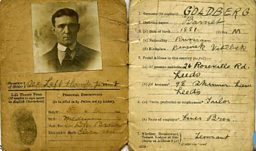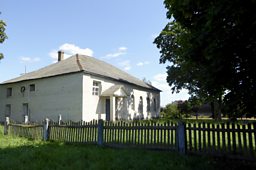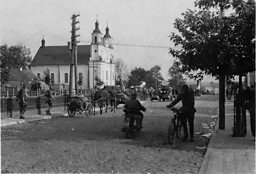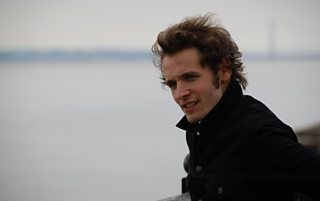From Russia with Love: A Migration Story

Rebecca Miller was a Jewish migrant, one of the many thousands who came to Britain in the early 1900s from Russia.
She travelled to Yorkshire in 1907, arriving with little money but dreams of a brighter future.
Like many Jewish immigrants, she was tempted by the prospect of work in the booming tailoring industry of Leeds.
Rebecca followed in the footsteps of her two brothers who had migrated earlier, escaping poverty, pogroms and anti-Semitism in their homeland.
Their journey to Leeds from Russia was long and arduous, taking 10 days. They were forced to leave behind half of their family in Russia including their parents and cousins.
Rebecca and her brothers were never to see their family again… and after the Second World War, the letters from back home stopped abruptly.
Exodus

Around 2.5 million Jewish migrants left the Baltic states of Russia between 1880-1920. The ports of Hull and Grimsby were major destinations for hundreds of thousands of Jews.
Rebecca Miller was one of them, travelling alone, aged 18 and speaking no English, only Yiddish. Film director Simon Glass is Rebecca Miller’s great grandson and now lives in London.
For the first time in his family’s history, he has traced Rebecca’s journey in a �鶹�� documentary called ‘A Very British History – the Jews of Leeds’ (�鶹�� Four, 25 February 2019 – 21:00).

It was a journey made by thousands of other Jewish migrants from across Europe – Lithuania, Latvia, Belarus, Poland, Russia and Ukraine, then mostly part of Russian Pale of Settlement where Jews were allowed to live.
Simon discovered that Rebecca travelled by rail over land from a small village called Vasilishok, which is now in Belarus.
She made the six hour journey to Vilnius in Lithuania and then onwards to Libau on the Baltic coast.
From Libau, she boarded a steamship to Hull with other Jewish migrants, a trip which lasted 5-7 days. Conditions on board were appalling.

The trip across the Kattegat and the North Sea was frequently rough and many Jewish migrants were seasick.
There was virtually no sanitation. The migrants were often transported alongside horses bound for the Yorkshire coalfield.
Excrement from the animals frequently leaked onto the decks below where migrants were swamped with sewage.
Life wasn’t much better when the migrants first arrived in Britain, exhausted and penniless.
Arriving in a new land

Arriving at the busy and noisy docks in Hull must have been like coming to a strange new world.
Some migrants mistakenly believed they were in New York as many had bought Trans-Atlantic tickets to the USA.
As thousands of migrants poured into Hull every week, special facilities were built to ‘process’ them, including an Immigrants’ Waiting Room next to the railway station.
Rebecca Miller landed at Victoria Dock and was checked by the authorities before catching a migrants’ train to Leeds from Hull Paragon Station.
When the migrants arrived in Yorkshire, many knew just one word of English – ‘Leeds’. The city was seen as a modern day ‘El Dorado’.
Its most famous immigrant, Michael Marks, was the best known ‘rags to riches’ story.
He’d arrived penniless from Belarus but went on to found the M&S retail empire in Leeds with Yorkshireman, Tom Spencer.

Montague Burton from Lithuania was another success story. He founded a tailoring firm and his Leeds factory became the largest in the world, producing ready made suits (spawning the phrase ‘the full monty’).
But for other migrants, life was harder and there were many challenges.
Life in The Leylands
Rebecca Miller’s brothers, Israel and Henry Miller, and their uncle Abraham settled in a notorious slum called The Leylands.
This was the place where Jewish migrants were directed on their arrival in England. Rebecca was no exception.
Housing conditions were grim and anti-Semitism was not uncommon. There were anti-Jewish riots and disturbances in The Leylands in 1917.

It wasn’t long before Rebecca was working as a tailors’ finisher, one of the few jobs open to Jews who spoke little or no English.
A few years later, Rebecca married a fellow migrant called Barnet Goldberg who arrived in Leeds from Latvia around 1897.
They went on to have seven children and eventually moved to a better area of Leeds called Sheepscar. Today it is one of Leeds’ most ethnically diverse areas and popular with migrants and refugees.

But one important question always remained for Rebecca. What had happened to her father and cousins back in Russia?
There had been letters and postcards, but these stopped coming in 1940 after the outbreak of the Second World War.
One of the last messages from Belarus said, “We are lucky to have survived, all alive. Be always good in health and happy”.

Belarus – Journey of Discovery
In summer 2018, Simon Glass became the first member of his family to travel to Russia to discover what happened to the Millers.
His first port of call was Vilnius in Lithuania, once known as ‘the Jerusalem of the North’ because of its large community of around 110,000 Jews.
It was also the place mentioned on Rebecca Miller’s British ID card together with a Jewish shetl (small village) called Oschnarshok.
A search of historic records had proved fruitless… and no Millers could be traced.
But a trip to the Lithuanian State Archive in Vilnius revealed a surprising discovery - a map of Vasilishok, a small town with links to the Miller family.
Vasilishok was a name mentioned by Simon’s family down the years as the place where the Millers had lived before the war.
Today it is in the Republic of Belarus close to the Lithuanian border. It was one of many Jewish shetls or small towns in Russia where Jews lived and worked.

The Vasilishok map was the vital clue in unlocking the mystery of what had happened to the Millers.
It showed the exact plot of land where the Millers had lived in 1941.
Today it’s still a peaceful rural backwater. There are the same fruit trees bearing apples and plums as when the Millers lived there.
But one thing has changed. There are no longer any Jews living in the village. The only clue to Jewish life was the former synagogue which still stands to the rear of the village.

From Belarus with love
Simon Glass goes in search of his family's ancestors in Belarus.
Holocaust Secrets
But there were still unanswered questions. What had happened to the Miller family in Vasilishok?
A darker side to the Miller family story emerged when Simon met an elderly woman living in the village who remembered the Second World War.
Teresa Ginel-Gulbatzky told him how Nazi troops had driven into Vasilishok in 1941.
They occupied the town and took control of daily life before turning their attentions to suppressing its Jewish community.

The Jews were herded into a ghetto in the village where they lived for the next year.
Amongst those trapped in the town were the Miller family. Their lives were about to change forever.
On May 10, 1942 a Nazi officer gave the order to round up the Jews in Vasilsihok. They were taken to a park close to the centre of the village.
Teresa Ginel-Gulbatzky lived opposite and witnessed what happened that day from her parent’s house. She was only 10 years old.

She told Simon Glass how the Jews were picked out and taken in small groups to the park.
Over 2,000 men, women and children were shot dead in plain sight of the village.
Her strongest memory is of a young girl of her own age with plaited hair who was left lying on a cart.
“I remember this beautiful girl, and she was on one of these carts. And her long ponytail was actually lying down from this cart. That stuck so much in my memory, it was so terrible” – Teresa Ginel.

The dead were taken away to a house in the village where the bodies were piled up. Later they were dumped in pits on the edge of the village.
Teresa remembers it as the worst day of her life.
“I remember on that day all the Jews were brought from the ghetto. They were made to lie down in a row, all of them, on the ground… and we heard shots.
“It was so bitter – they were all our neighbours. They always lived so peacefully with us.”
There was only one survivor, Shale Kushner, who hid in houses for months before escaping to the USA to tell his tale.

Simon Glass learned that a dozen Miller family members were amongst the dead including Rebecca’s cousins.
Boris Miller, a carpenter, had been a Jewish partisan fighting against the Nazis. He was 27 years old.
Also murdered were Benyamin Miller and his wife Khaya, a young couple.
Amongst the Holocaust victims was another cousin, Shmuel Miller who had been sent to Camp Stalag 1A near Konigsberg where he had been working
Only two of the Miller cousins, Ester and Shoylme, escaped because they had migrated to Palestine before the war.
Today the Millers who stayed in Belarus lie buried in a mass grave on the edge of the village. Their Catholic neighbours erected a monument to commemorate their Jewish friends in the 1990s.

For Simon Glass it has a been an emotional journey:
“To see a mass grave where people who share my genetic make-up are buried is really the most terrible thing I have ever experienced.
“I’ve been to Holocaust sites and concentration camps all over Europe but the trip to Vasilishok rocked me. It’s different when it’s your relatives.”
For the descendants of the Miller family back in Leeds, at least they have a sense of closure.
“At least some of the Millers got out and came to Leeds. We wouldn’t be here today if Rebecca Miller and her brothers had stayed behind.
“We are the lucky ones.”
Written by Sue Wilkinson, Associate Producer, A Very British History.

About the programme
Film maker Simon Glass explores the ‘lost world’ of the Jews in Yorkshire in the early 20th Century.

Hundreds of thousands of Jewish migrants and refugees travelled from the Baltic states of Russia to British ports between 1880-1920.
Many were fleeing poverty and persecution; some worked and settled in Leeds. They arrived with little money, but hoped and dreamed of a brighter future.
Simon travels to Lithuania and Belarus to find out more about his family roots, and what happened to those who did not make the journey to Leeds.
In an emotional journey he makes shocking discoveries about what happened as the horrors of World War Two unfold.
Discover more about A Very British History: The Jews of Leeds
